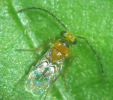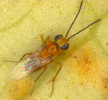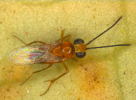 |
Scientific nameLeptomastix dactylopii Howard [=Paraleptomastix dactylopii Howard, Leptomastix longipennis Mercet, Leptomastix bifasciatus Compere, Leptomastix tambourissae Risbec (Noyes & Hayat, 1994; Noyes, 2005)]
Taxonomic positionHymenoptera: Chalcidoidea: Encyrtidae: Tetracneminae
DiagnosisFemale: Head yellow or orange with a dark brown area adjacent to each eye at temple which extends across occiput towards foramen. Antenna with scape orange with dorsal margin dark brown, pedicel dusky orange to brown, at least 2 x as long as broad, flagellum dark brown. Thorax orange, covered with dark brown setae; occasionally mesoscutum and axillae distinctly dusky; metanotum orange; mesopleuron orange; mesosternum anterior to each coxal insertion dark brown. Wings hyaline, forewings occasionally infuscate along anterior margin and longitudinally in middle from below stigmal vein to wing apex, about 2.6-3.0 x as long as broad; linea calva interrupted by at most two lines of setae; marginal vein longer than stigmal, but shorter than postmarginal which is between 1.5 and 2x as long as stigmal vein. Gaster dorsally dark orange-brown to brownish orange ventrally, about as long as thorax, ovipositor not exserted. Posterior ocelli equidistant from occipital and eye margin or slightly closer to eye margins.
Male: Length 0.83-1.46 mm. Generally similar to female in coloration, occasionally pronotum and anterior margin of mesoscutum entirely dark brown, ocelli much closer to occipital than to eye margin; antenna clothed in setae the longest of which is about 4x as long as diameter of any segment; base of clava with a line of about ten scale-like sensilla ventrally; basal cell of forewing with three to five lines of setae proximal to linea calva, normally a distinct naked area between the distad line and the remaining proximad lines, linea calva interrupted by at most one or two setae.  Leptomastixdactylopii: Antenna and forewing venation (lc - linea calva) Leptomastixdactylopii: Antenna and forewing venation (lc - linea calva)For detailed descriptions of both sexes with illustrations, refer to Noyes & Hayat (1994). ImagesDistributionNative of South America. Introduced in Canada, USA, Caribbean, Mediterranean Europe, Africa, Australia, Hawaii, and the Indian subcontinent (India; Pakistan). Noyes & Hayat (1994) provide a detailed account of the worldwide introduction / use of L. dactylopii.
Introduced in India in 1983 from the West Indies for the biological control of citrus mealybug, Planococcus citri (Risso) (Krishnamoorthy & Singh, 1987) and later in Pakistan in 1984 and 1985. Presently well established in south Indian states such as Kerala, Karnataka and Tamil Nadu. Host range and biologyPlanococcus citri (Risso), P. comstocki, P. lilacinus, Pseudococcus longispinus, Ferrisia virgata, Dysmicoccus brevipes and several other species of mealybugs have been recorded as hosts in the field and / or laboratory. In India, it is apparently specific to P. citri in field conditions on horticultural and plantation crops like citrus, coffee, pomegranate, guava, grapevine, etc. (For complete list of hosts from different parts of the world, refer to Noyes &
Hayat, 1994; Universal Chalcidoidea Database, and ScaleNet).
It is a solitary internal parasitoid and takes 17-21 days to complete its life cycle on P. citri. Third instar nymphs and adults are preferred for oviposition and the development is faster on the later stages of the mealybug. For mass rearing, 15-20 day-old females of P. citri are ideal and more parasitoid females are obtained when partially gravid females of P. citri are exposed to the parasitoid. Mass production and releaseMass production is done on ripe pumpkins infested with 15-20 day-old P. citri. Leptomastix dactylopii is used often in conjunction with the coccinellid predator, Cryptolaemus
montrouzieri Mulsant, to control Planococcus spp. in several horticultural crops such as coffee, grapevine, guava, etc. The recommended rate of release is 2000 per tree (for inoculative releases, 3000 or more numbers are needed). Detailed mass production procedure is given by Singh (1994).
References
|






